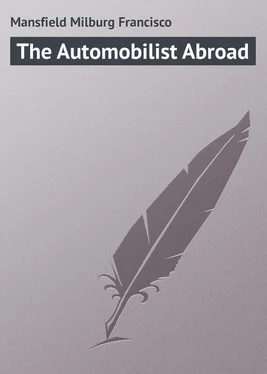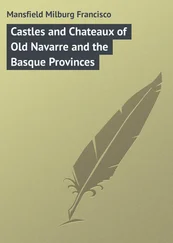Milburg Mansfield - The Automobilist Abroad
Здесь есть возможность читать онлайн «Milburg Mansfield - The Automobilist Abroad» — ознакомительный отрывок электронной книги совершенно бесплатно, а после прочтения отрывка купить полную версию. В некоторых случаях можно слушать аудио, скачать через торрент в формате fb2 и присутствует краткое содержание. Жанр: Путешествия и география, foreign_prose, foreign_language, на английском языке. Описание произведения, (предисловие) а так же отзывы посетителей доступны на портале библиотеки ЛибКат.
- Название:The Automobilist Abroad
- Автор:
- Жанр:
- Год:неизвестен
- ISBN:нет данных
- Рейтинг книги:4 / 5. Голосов: 1
-
Избранное:Добавить в избранное
- Отзывы:
-
Ваша оценка:
- 80
- 1
- 2
- 3
- 4
- 5
The Automobilist Abroad: краткое содержание, описание и аннотация
Предлагаем к чтению аннотацию, описание, краткое содержание или предисловие (зависит от того, что написал сам автор книги «The Automobilist Abroad»). Если вы не нашли необходимую информацию о книге — напишите в комментариях, мы постараемся отыскать её.
The Automobilist Abroad — читать онлайн ознакомительный отрывок
Ниже представлен текст книги, разбитый по страницам. Система сохранения места последней прочитанной страницы, позволяет с удобством читать онлайн бесплатно книгу «The Automobilist Abroad», без необходимости каждый раз заново искать на чём Вы остановились. Поставьте закладку, и сможете в любой момент перейти на страницу, на которой закончили чтение.
Интервал:
Закладка:
In the Pyrenees, and in the Alps of Savoie and Dauphiné, one finds everywhere the insignia of the "Club-Alpin Français," which caters with information, etc., not only to the mountain-climber, but to the automobilist and the general tourist as well.
More powerful and effective than all – more so even than the famous Automobile Club de France – is the great Touring Club de France, which, with the patronage of the President of the Republic, and the influence of more than a hundred thousand members, is something more than a mere touring club.
In the fourteen years of its existence not only has the Touring Club de France helped the tourist find his way about, but also has taken a leading part in the clearing away of the debris in many a moss-grown ruin and making of it a historical monument as pleasing to view as Jumièges on the Seine, or world-famed Les Baux in Provence.
It has appointed itself the special guardian of roads and roadways, so far as the placing of signboards along the many important lines of communication is concerned; it has been the means of having dug up untold kilometres of Renaissance pavement; has made, almost at its own expense, a magnificent forty-kilometre road known as the Corniche de l'Esterel; and has given the backward innkeeper such a shock that he has at last waked up to the needs of the twentieth-century traveller. All this is something for a touring organization to have accomplished, and when one can become a part and parcel of this great organization, and a sharer in the special advantages which it has to offer to its members for the absurdly small sum of five francs per annum, the marvel is that it has not half a million members instead of a hundred thousand.
Chapter III
Roads & Routes
The chief concern of the automobilist to-day, after his individual automobile, is the road question, the "Good Roads Question," as it has become generally known. In a new country, like America, it is to be expected that great connecting highways should be mostly in the making. It is to be regretted that the development should be so slow, but things have been improving in the last decade, and perhaps America will "beat the world" in this respect, as she has in many others, before many future generations have been born.
In the excellence and maintenance of her roads France stands emphatically at the head of all nations, but even here noticeable improvement is going on. The terrific "Louis Quatorze pavé," which one finds around Paris, is yearly growing less and less in quantity. The worst road-bed in France is that awful stretch from Bordeaux, via Bazas, to Pau in Navarre, originally due to the energy of Henri IV., and still in existence for a space of nearly a hundred kilometres. One avoids it by a détour of some twenty odd kilometres, and the writer humbly suggests that here is an important unaccomplished work for the usually energetic road authorities of France.
After France the "good roads" of Britain come next, though in some parts of the country they are woefully inadequate to accommodate the fast-growing traffic by road, notably in London suburbs, while some of the leafy lanes over which poets rhapsodize are so narrow that the local laws prevent any automobile traffic whatever. As one unfortunate individual expressed it, "since the local authorities forbid automobiles on roadways under sixteen feet in width, I am unable to get my motor-car within nine miles of my home!"
In England something has been done by late generations toward roads improvement. The first awakening came in 1820, and in 1832 the London-Oxford road had been so improved that the former time of the stage-coaches had been reduced from eight to six hours. Macadam in 1830, and Stevenson in 1847, were the real fathers of the "Roads Improvement Movement" in England. The great faults of English roads are that they are narrow and winding, almost without exception. There are 38,600 kilometres of highways (the figures are given on the metric scale for better comparison with Continental facts and figures) and 160,900 of by-roads. There are sixty-six kilometres of roads to the square kilometre (kilometre carré) .
In Germany the roads system is very complex. In Baden, the Palatinate, and the Grand Duchy of Hesse they cede nothing to the best roads anywhere, but in the central and northern provinces they are, generally speaking, much poorer. There are fifty-four kilometres of roads of all grades to the kilometre carré .
In Belgium the roads are greatly inferior to those of France, and there are immeasurable stretches of the vilest pavement the world has known, not only near the large towns, but great interior stretches as well. There are 17,500 kilometres of Chemins Vicinaux and 6,990 kilometres of Chemins de Grands Communications. They average, taken together, eighty-three kilometres to the kilometre carré .
In Switzerland the roads are thoroughly good everywhere, but many, particularly mountain-roads, are entirely closed to automobile traffic, and the regulations in many of the towns are so onerous that it is anything but agreeable to make one's way through them. There are thirty-two kilometres to the kilometre carré . The Simplon Pass has only recently (1906) been opened to automobile traffic. No departure can be made from Brigue, on the Swiss side, or from Gondo, in Italy, after three P.M. Speed (vitesse) must not exceed ten kilometres on the stretches, or two kilometres around the corners. Fines for infringement of the law run from twenty to five hundred francs.
Italy, with a surface area one-half that of France, has but a quarter of the extent of the good roads. They are of variable quality, but good on the main lines of travel. In the ancient kingdom of Sardinia will be found the best, but they are poor and greatly neglected around Naples, and, as might be expected, in Sicily.
In Austria the roads are very variable as to surface and maintenance, and there are numerous culverts or canivaux across them. There are 21,112 kilometres of national roads, 66,747 kilometres of provincial roads, and 87,859 of local roads. They average fourteen kilometres to the kilometre carré .
The history of the development of the modern roadway is too big a subject to permit of its being treated here; suffice it to recall that in England and France, and along the Rhine, the lines of the twentieth-century main roads follow the Roman roads of classic times.
In France, Lyons, in the mid-Rhône valley, was a great centre for the radiating roadways of Gaul. Strategically it was important then as it is important now, and Roman soldiery of the past, as the automobilist of to-day, had here four great thoroughfares leading from the city. The first traversed the valleys of the Rhine and the Meuse; the second passed by Autun, Troyes, Chalons, Reims, Soissons, Noyon, and Amiens; the third branched in one direction toward Saintes, and in another to Bordeaux; while the fourth dropped down the Rhône valley direct to Marseilles.
More than thirty thousand kilometres of roadways were in use throughout Gaul during the Roman occupation, of which the four great routes (viæ publicæ) formed perhaps four thousand.
Of the great highways of France, the Grandes Routes Nationales , of which all travellers by road have the fondest and most vivid memories, it is well to recall that they were furthered, if not fathered, by none other than Napoleon, who, for all he laid waste, set up institutions anew which more than compensated for the destructions.
The great roadways of France, such as the Route de Bretagne, running due west from the capital, and those leading to Spain, Switzerland, Italy, and the Pays Bas, had their origin in the days of Philippe-Auguste. His predecessors had let the magnificently traced itineraries of the Romans languish and become covered with grass – if not actually timber-grown.
Читать дальшеИнтервал:
Закладка:
Похожие книги на «The Automobilist Abroad»
Представляем Вашему вниманию похожие книги на «The Automobilist Abroad» списком для выбора. Мы отобрали схожую по названию и смыслу литературу в надежде предоставить читателям больше вариантов отыскать новые, интересные, ещё непрочитанные произведения.
Обсуждение, отзывы о книге «The Automobilist Abroad» и просто собственные мнения читателей. Оставьте ваши комментарии, напишите, что Вы думаете о произведении, его смысле или главных героях. Укажите что конкретно понравилось, а что нет, и почему Вы так считаете.












